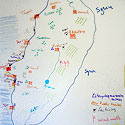Found 4305 matches from 1,400 records in about 0.1137 seconds for phone or e or geodeta.
 How startling seeing some of those old demo flyers from nearly 10 years ago. Those were emotional days on the streets of New York, trying to help where needed and to reign in the war machine.
How startling seeing some of those old demo flyers from nearly 10 years ago. Those were emotional days on the streets of New York, trying to help where needed and to reign in the war machine.In July 2009, I noted a study concluding that Brazil’s telenovelas have inspired both a drop in birth rate and rise in divorce. Via the Communication Initiative Network, I found a a few other items on soap operas and public health:

- A German report looks at TV soap operas in Kyrgyzstan, the Dominican Republic, and Côte d’Ivoire as vehicles for HIV/AIDS education.
- A radio soap opera in Vietnam reached millions of farmers changing their attitudes and practices managing rice pests, fertilisers, and seeds.
- Authors of a 2006 paper on a radio soap opera in Bihar, India document how it spurred fundamental, sustainable shifts in people’s values and beliefs.
- A May 2008 Master’s thesis looks at the effect of two Ethiopian radio dramas on attitutde towards reproductive health and spousal abuse.
- Fans of a radio drama in Sudan learned about, or were reinforced in, the importance of abandoning female circumcision, giving girls more control of their reproductive health, having a small family, and staying away from drugs and alcohol.
And though I couldn’t find a study on its impact, straphangers in New York City may remember Julio and Marisol: Decision, an episodic comic strip soap opera dealing with AIDS that ran in English and Spanish in NYC subway cars from 1989 through 2001.
I’ve added three new items to my growing list of design manifestos, all from 2010.
- January 2010: The Role of Design in the 21st Century, a manifesto and vision for the future of Danish design from the multidisciplinary Danish Design Association.
- September 2010: Anti-Design Festival Manifesto. Tomorrow the Anti Design Festival kicks off in the UK as a counter-event to the London Design Festival, both a protest against its “pretty commerciality” and attempt to “unlock creative fires and ideas, exploring spaces hitherto deemed out-of-bounds by a purely commercial criteria.”
- August 2010: The Obstructionist Manifesto. Mark Goldman writes against harmful, heavy-handed, insider-driven city planning.
 In June I wrote about Conflict Kitchen, a pop-up, take-out restaurant in Pittsburg that only serves cuisine from countries that the United States is in conflict with. In October, Kubideh Kitchen will go out of business and change identities to highlight and provoke discussion around Afghan culture. The organizers have started a Kickstarter campaign to raise $4,000 by the end of September. Donations will go towards the creation Bolani Pazi, which will serve Afghan food wrapped in a custom-designed wrapper printed with Afghan perspectives and opinions. Pledges of $15 or more will receive copies of the stylish (and informative) food wrapper designs from both Kubideh Kitchen and Bolani Pazi.
In June I wrote about Conflict Kitchen, a pop-up, take-out restaurant in Pittsburg that only serves cuisine from countries that the United States is in conflict with. In October, Kubideh Kitchen will go out of business and change identities to highlight and provoke discussion around Afghan culture. The organizers have started a Kickstarter campaign to raise $4,000 by the end of September. Donations will go towards the creation Bolani Pazi, which will serve Afghan food wrapped in a custom-designed wrapper printed with Afghan perspectives and opinions. Pledges of $15 or more will receive copies of the stylish (and informative) food wrapper designs from both Kubideh Kitchen and Bolani Pazi.Update 9/25/10: Success! $4,178 raised!
I don’t usually blog about events, but I like how the model here approaches something of an incubator:
“A three day hands-on workshop (5 - 8 December 2010, in Jordan), for activists and NGOs in the Arab region, working on women’s rights, to explore how visual techniques can strengthen campaigning. The workshop will give participants the skills to plan and strategise visual campaigns, think about how to use information effectively and gain hands-on skills to develop a campaign using information design, mapping and animation/imaging techniques....
We invite applications for those working on women’s rights issues, in particular violence against women, the impact and role of women in political and violent conflict and women’s participation and leadership in public life. We also welcome communications specialists, designers, artists, illustrators, or technologists working with mapping techniques or data who can support women’s rights activists. 35 to 40 applicants will be selected to attend the launch workshop in Jordan in December. Participants will have to bring with them a campaign idea which will be developed over the course of three days. Of these, 10 campaigns will be provided with small-scale follow up support and mentoring to implement the visualisation element of their campaign in early 2011.”
They also have a project blog highlighting examples of visualisations. Applications to attend the workshop are due October 14, 2010.

Civil society in Lebanon is blossoming. The number of registered NGOs has increased dramatically in recent years and as advocacy campaigns become more sophisticated, there is a growing appetite for learning new techniques for conveying ones messages. I was invited by the US State Department Speaker Specialist Program to work with the Social Media Exchange (SMEX) in Beirut to conduct a week of workshops for local and international NGO staff on visual thinking and information design for advocacy.
Building on my work and my 2008 booklet Visualizing Information for Advocacy: An Introduction to Information Design, I devised three day-long workshops which were announced as follows:

Each year Project Censored compiles a list of 25 urgent stories that are grossly underreported. But on this year’s chilling list, the scale of this one is just staggering:
“The US military is responsible for the most egregious and widespread pollution of the planet, yet this information and accompanying documentation goes almost entirely unreported. In spite of the evidence, the environmental impact of the US military goes largely unaddressed by environmental organizations and was not the focus of any discussions or proposed restrictions at the recent UN Climate Change Conference in Copenhagen. This impact includes uninhibited use of fossil fuels, massive creation of greenhouse gases, and extensive release of radioactive and chemical contaminants into the air, water, and soil.
The extensive global operations of the US military (wars, interventions, and secret operations on over one thousand bases around the world and six thousand facilities in the United States) are not counted against US greenhouse gas limits.…
As it stands, the Department of Defense is the largest polluter in the world, producing more hazardous waste than the five largest US chemical companies combined. Depleted uranium, petroleum, oil, pesticides, defoliant agents such as Agent Orange, and lead, along with vast amounts of radiation from weaponry produced, tested, and used, are just some of the pollutants with which the US military is contaminating the environment.”
The horror goes on and on and on.
And it makes me think a lot of sustainable designers may be fighting the wrong war.
Nancy Duarte’s Slide:ology is one of my favorite design books. And this bit is particularly great: seven questions to help understand your target audience. Though intended as a guide for your design process, I think this touches something very human and applies not just to information architecture and design, but to political advocacy as well.
I’ve shamelessly adapted a version of this for a talk on design and advocacy, but here’s the raw source:
Seven Questions to Knowing Your Audience
“The audience didn’t come to see you, they came to see what you can do for them. If you fill out this audience persona slide, it will give you insights into how to present in a way that will resonate with your audience.
- What are they like?
Demographics and psychographics are a great start, but connecting with your audience means understanding them on a personal level. Take a walk in their shoes and describe what their life looks like each day.
- Why are they here?
What do they think they’re going to get out of this presentation? Why did they come to hear you? Are they willing participants or mandatory attendees? This is also a bit of a situation analysis.
- What keeps them up at night?
Everyone has a fear, a pain point, a thorn in the side. Let your audience know you empathize—and offer a solution.
- How can you solve their problem?
What’s in it for the audience? How are you going to make their lives better?
- What do you want them to do?
Answer the question “so what?” Make sure there’s clear action for your audience to take.
- How might they resist?
People vary in how they receive information. This can include the set up of the room to the availability of materials after the presentation. Give the audience what they want, how they want it.
- How can you best reach them?
What will keep them from adopting your message and carrying out your call to action?
You can also download it from Duarte Design as a PowerPoint slide.

The board of the largest professional organization of designers in the US, the AIGA, has quietly amended their Standards of Professional Practice to include these new additions:
“7.2 A professional designer is encouraged to contribute five percent of his or her time to projects in the public good—projects that serve society and improve the human experience.
7.3 A professional designer shall consider environmental, economic, social and cultural implications of his or her work and minimize the adverse impacts.”
While it’s not quite a Hippocratic Oath for designers it’s great to see the AIGA finally institutionalize and push an ongoing commitment to design in the public interest.
page 1 2 3 4 5 6 7 8 9 10 11 12 13 14 15 16 17 18 19 20 21 22 23 24 25 26 27 28 29 30 31 32 33 34 35 36 37 38 39 40 41 42 43 44 45 46 47 48 49 50 51 52 53 54 55 56 57 58 59 60 61 62 63 64 65 66 67 68 69 70 71 72 73 74 75 76 77 78 79 80 81 82 83 84 85 86 87 88 89 90 91 92 93 94 95 96 97 98 99 100 101 102 103 104 105 106 107 108 109 110 111 112 113 114 115 116 117 118 119 120 121 122 123 124 125 126 127 128 129 130 131 132 133 134 135 136 137 138 139 140 141 142 143 144 145 146 147 148 149 150 151 152 153 154 155 156 157 158 159 160 161 162 163 164 165 166 167 168 169 170 171 172 173 174 175 176 177 178 179 180 181 182 183 184 185 186 187 188 189 190 191 192 193 194 195 196 197 198 199 200 201 202 203 204 205 206 207 208 209 210 211 212 213 214 215 216 217 218 219 220 221 222 223 224 225 226 227 228 229 230 231 232 233 234 235 236 237 238 239 240 241 242 243 244 245 246 247 248 249 250 251 252 253 254 255 256 257 258 259 260 261 262 263 264 265 266 267 268 269 270 271 272 273 274 275 276 277 278 279 280 281 282 283 284 285 286 287 288 289 290 291 292 293 294 295 296 297 298 299 300 301 302 303 304 305 306 307 308 309 310 311 312 313 314 315 316 317 318 319 320 321 322 323 324 325 326 327 328 329 330 331 332 333 334 335 336 337 338 339 340 341 342 343 344 345 346 347 348 349 350 351 352 353 354 355 356 357 358 359 360 361 362 363 364 365 366 367 368 369 370 371 372 373 374 375 376 377 378 379 380 381 382 383 384 385 386 387 388 389 390 391 392 393 394 395 396 397 398 399 400 401 402 403 404 405 406 407 408 409 410 411 412 413 414 415 416 417 418 419 420 421 422 423 424 425 426 427 428 429 430 431
[ Back ]
[ Next ]


